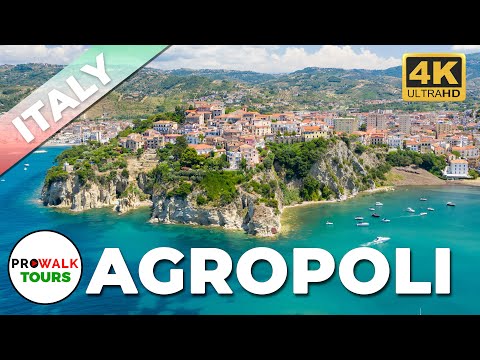Agropoli, Italy Walking Tour - 4K - Prowalk Tours

Welcome to Agropoli, Italy! Agropoli is a small coastal town located in the region of Campania in central Italy. This walk was filmed on a windy day and I apologize for loud wind noise at times. This street is Via Filippo Patella which leads up to the small historic center of town and the Castello Argioino Aragonese. The street up ahead to the left leads directly down to the Port of Agropoli. Agropoli is only about 10km (20 minutes) south of the Greek ruins of Paestum which have also been featured on this channel.
The name of the town actually derives from the Greek Akropolis meaning "city built on the top." Agropoli began as a Greek settlement and they called this rocky promontory Petra, meaning "rocky hill." The Greeks built a temple at the top of the hill dedicated to Artemis, the Goddess of Hunting. The medieval Angioino Aragonese Castle is now built on that site. By the 1st century BC, a coastal town called Ercula, in honor of Hercules, had been established on the northern side of the hill. The town of Ercula developed and flourished, but in the 5th century AD, the Vandals made life difficult in Ercula.
The people of Ercula retreated up to this hill which offered a better defense. Then, in the 6th century, the Byzantines needed a secure, well protected harbor, and they fortified this hill and called it Acropolis. The town remained under control of the Byzantines until 882, when Acropolis was seized by the Saracen pirates. The pirates used Acropolis as a base from which they could set out and plunder the surrounding areas along the Amalfi Coast. We will walk down these steps to the port here shortly.
By 915 AD, Acropolis had been liberated from the Saracens and came back under the jurisdiction of the bishops. For centuries, these steps provided the only access to the town. After passing through the gate up ahead we will be at the scenic square of the Church of Santa Maria of Constantinople.
Above the main door you can see the marble coat of arms of the Dukes Delli Monti Sanfelice, the last feudal owners of the city. The gate is part of the original 7th century city walls. After touring the castle, we will return by walking down these steps. This church was built around 1583, after a statue of the Madonna was discovered in the sea, which the Turks tried to steel during a raid. Agropoli remained under the protection of the bishops for the rest of the medieval period until 1412 when Pope Gregory XII gave the territory to King Ladislas of Durazzo to pay off a war debt. Throughout the 16th and 17th centuries, possession of Agropoli was passed on to various families.
It was during that time that Agropoli was again frequently attacked by Saracen pirates. On June 30th, 1630, over 700 Turkish pirates attacked the city but the people of Agropoli joined forces with the surrounding towns and were able to defeat the pirates. It wasn't until the 19th century that Agropoli began to expand outside its medieval walls. To recap, Agropoli was founded by the Greeks, fortified by the Byzantines then underwent the succession of the Normans, Swabians, Angevins and Aragonese. We are now walking towards the Angevin-Aragonese Castle which was originally built by the Byzantines in the 6th century.
The Normans made improvements to the castle and enlarged the city walls between 1077 and 1189. This church is dedicated to Peter and Paul, the patron saints of the city. This door depicts a scene of a couple walking up the steps to the ancient gate we were just at.
This other door shows reliefs of Peter and Paul. During the 1600s, the castle became the property of the DelliMonti Sanfelice family and it stayed in their family until 1806. The castle was eventually abandoned before being purchased by the city.
I would like to mention that this worker allowed me to enter for free. The machine was only accepting coins at the time and I only had bills. This is looking north towards Paestum and on up the coast to Salerno. The castle took on its current form during the 15th century. Today, the interior of the castle is used as a garden as well as an open air theater. Luisa Sanfelice, who played a minor role in the Neapolitan Revolution of 1799, resided at the castle on several locations.
She was condemned to death by beheading in Naples for conspiring with the French and their supporters against the Kingdom of the Two Sicilies. Her story inspired the novel La San Felice by Alexandre Dumas in 1864. The novel was used as the basis for the 1942 film, Luisa Sanfelice. This walk ends down along the beach in the distance. Why is the European Union flag flown on top? I don't know.
This is part of the moat that once surrounded the castle. Agropoli is located in an area of Italy known as the Cilento Coast. The territory of Cilento stretches out from Paestum in the north on down the coast about 90 km to the town of Sapri.
The area is full of Greek ruins, beautiful beaches, mountains and the best Mozzarella di Bufala in Italy. The area gets completely ignored by tourists with the Amalfi Coast being just an hour to the north. Visitors to the castle can drive up from the opposite side of the hill and park here. This road to the right leads right back to the piazza where this walk began.
I arrived in Agropoli around 9:30 am but wanted stay until there were more people out during the evening passegiata. After finishing the walk, I hung out for a few hours until the evening when I started to film again. While I waited, I went to a few antique shops and ended up buying some old 8mm home movies and negatives from the 1940s. Finding and scanning in old home movies from the 1930s to 1960s is another one of my side hobbies. I will probably lose a few points with this statement, but I am not a huge fan of Italian food.... ....but when I do move back to the US, I will miss these sugar coated doughnuts called Graffe. Not all graffe are the same though. They are best fresh and steaming hot. :)
Some of my favorite toys. If you are enjoying this walk, please leave a LIKE and if you are not already a subscriber, I would appreciate it if you clicked on the subscribe button in the corner. All along the beach you will find vendors selling shave ice, known as a granitas, for one euro.
They use a hand held ice shaver to scrape an ice block. I bought three granitas on this beach after the walk. :) I can't wait any longer. I think it's time for a granita. Thanks for watching!
2021-02-13 09:02


